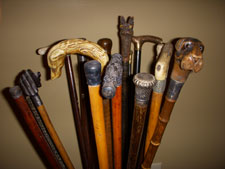|
|||
|
The Popularity of Canes
The history of the cane and the staff goes back to biblical times, and over the years canes have been used as religious and magical symbols, and as signs of authority or power. In more modern times, even up to the present, avidly collected canes have had handles made by Faberge and Tiffany, as well as those of elegantly carved ivory, jewel-inlaid wood, and intricately fashioned silver. The range of so-called systems canes is likewise very wide: there are ones that were hollowed to hold alcoholic beverages and substances such as tobacco, and ones that contained tools, gadgets of all sorts, and even musical instruments. There is, as well, a large category of canes as weapons.
A cane might be a walnut stick with a silver-plated handle or an ebony shaft with a custom made gold handle. A carved and painted cane could be considered folk art if it was made by a self-taught or nonacademic artist. Determining if a cane is American can be based on the type of wood, symbols (such as a flag), a proven provenance, or even the style of the carving. Canes were made in all fifty states. A cane can have decoration just on the handle or on the stick itself or both – so the cane could be seen as having a sculpture on it or may itself be a sculpture. References:
|
||||
|
Out with the Old With the ringing in of 2013 one might be tempted to invoke the old saying "Out with the old in with the new. Not so for us country antique lovers. For us it’s in with more old… and the older the better. In this disposable society it is refreshing that our breed of person values old things above all others. We treasure the patina from years of use. We look for good wear. Original surface reigns supreme. Above all, we love the history that a treasure holds. Too many today are caught up in the disposable way of life. With computers, phones and electronics becoming obsolete almost as soon as we get them, the tendency is to covet the next new thing. About Lyn Andeen
|
||||
|
We're Pinning for You! 2013 is off to a great start with a number of additions. Have you joined the milliions of people that are happily pinning images with Pinterest? Now you can find Dig Antiques with our own boards on Pinterest. Find us here and follow our boards - filled with images from the Shops on Dig Antiques. We have more exciting integrations with Pinterest planned, so stay tuned! We are looking forward to a fantastic 2013. Please join us by supporting Dig Antiques. Sincerely, |
|
Search Showcase Have you been digging for antiques recently? |
|
December 2012 Top Searches Below is a summary of the twenty most popular search phrases last month.
1. treen |
|
Sponsors |
|
Thank you to the following current advertisers for their support of Dig Antiques:
Baker & Co. Antiques If you are interested in supporting Dig Antiques through advertising, please click here. |
|
Contact Us |
|
For general information:
Website: www.digantiques.com |
|
© 2013 Dig Antiques. All rights reserved. |


